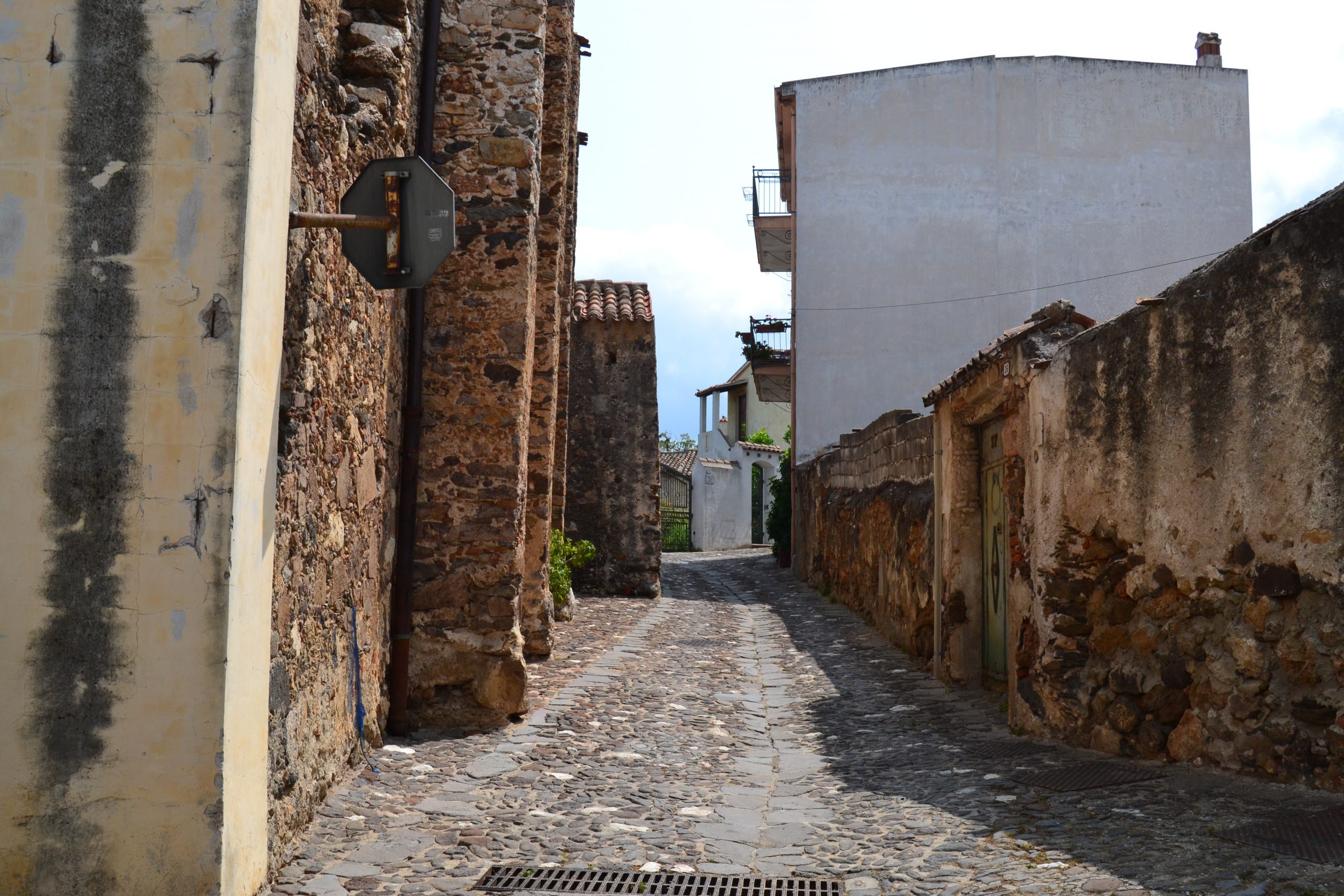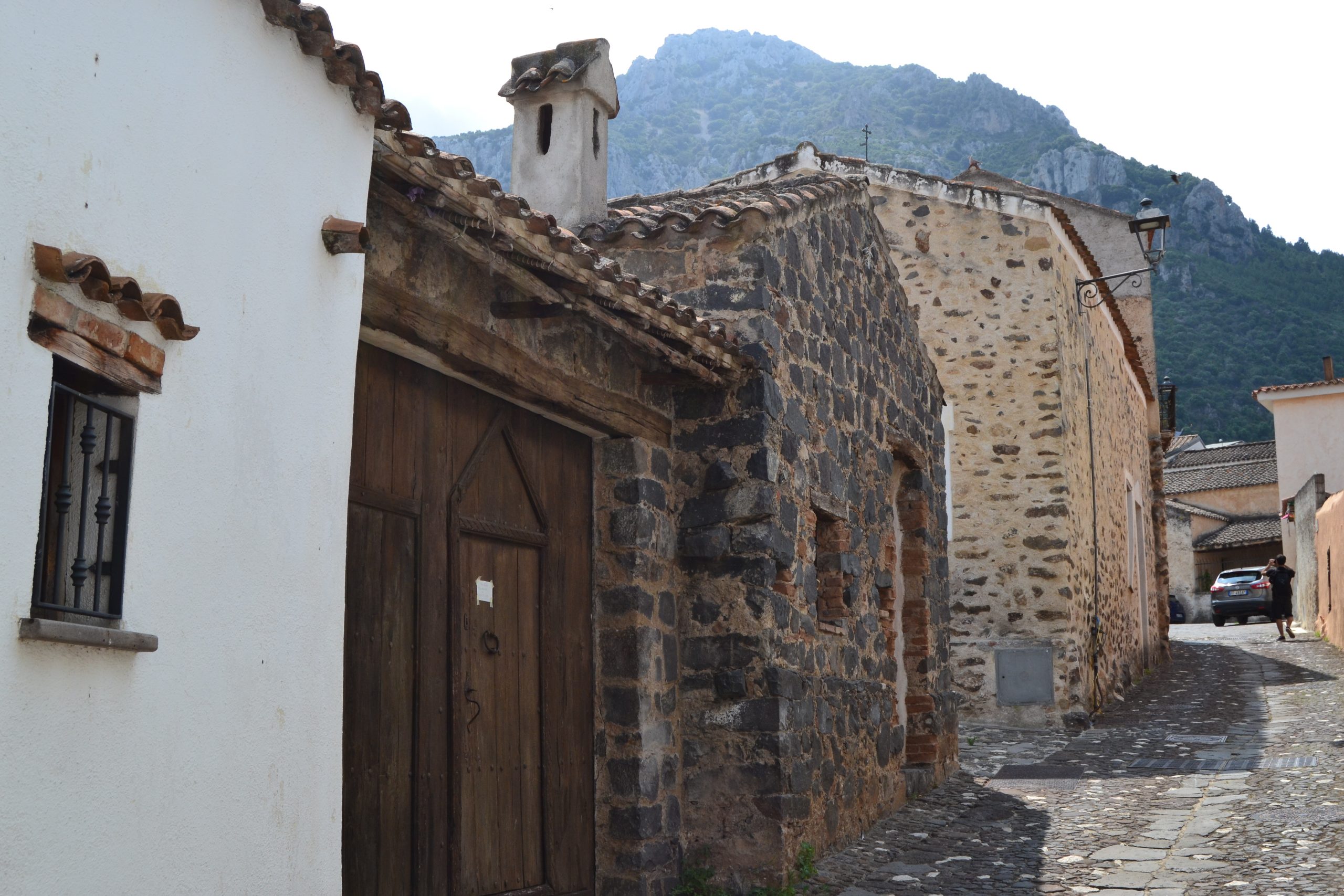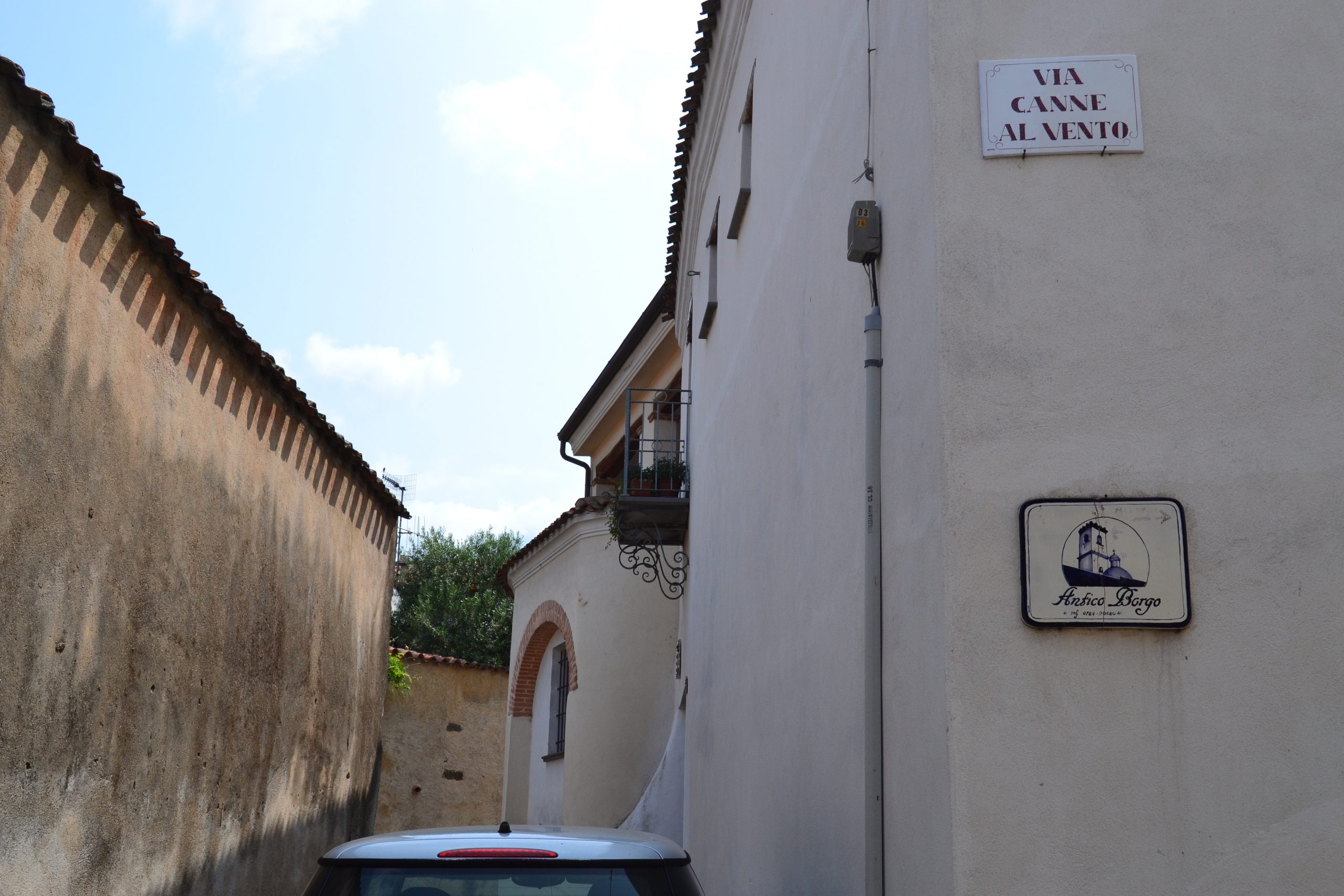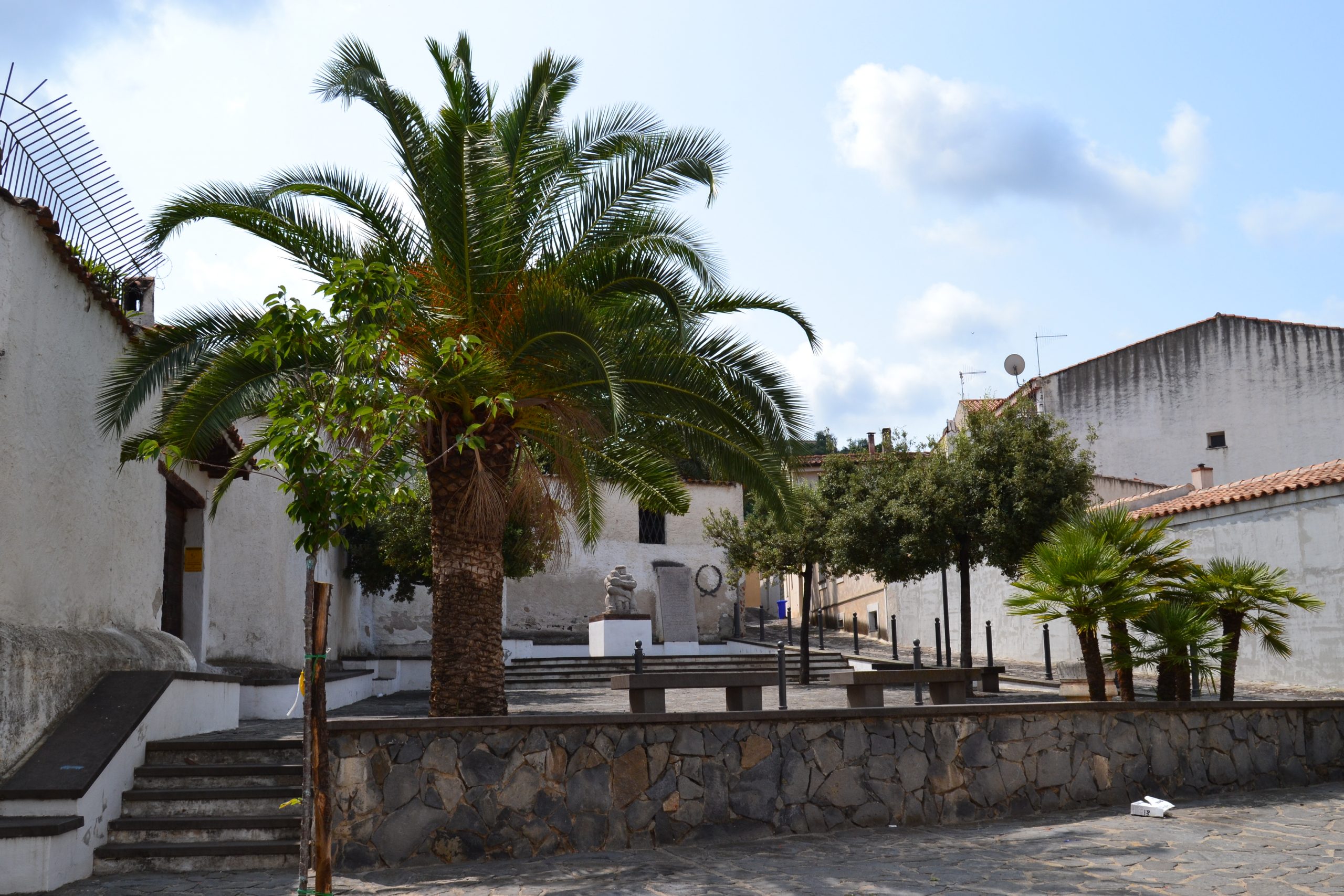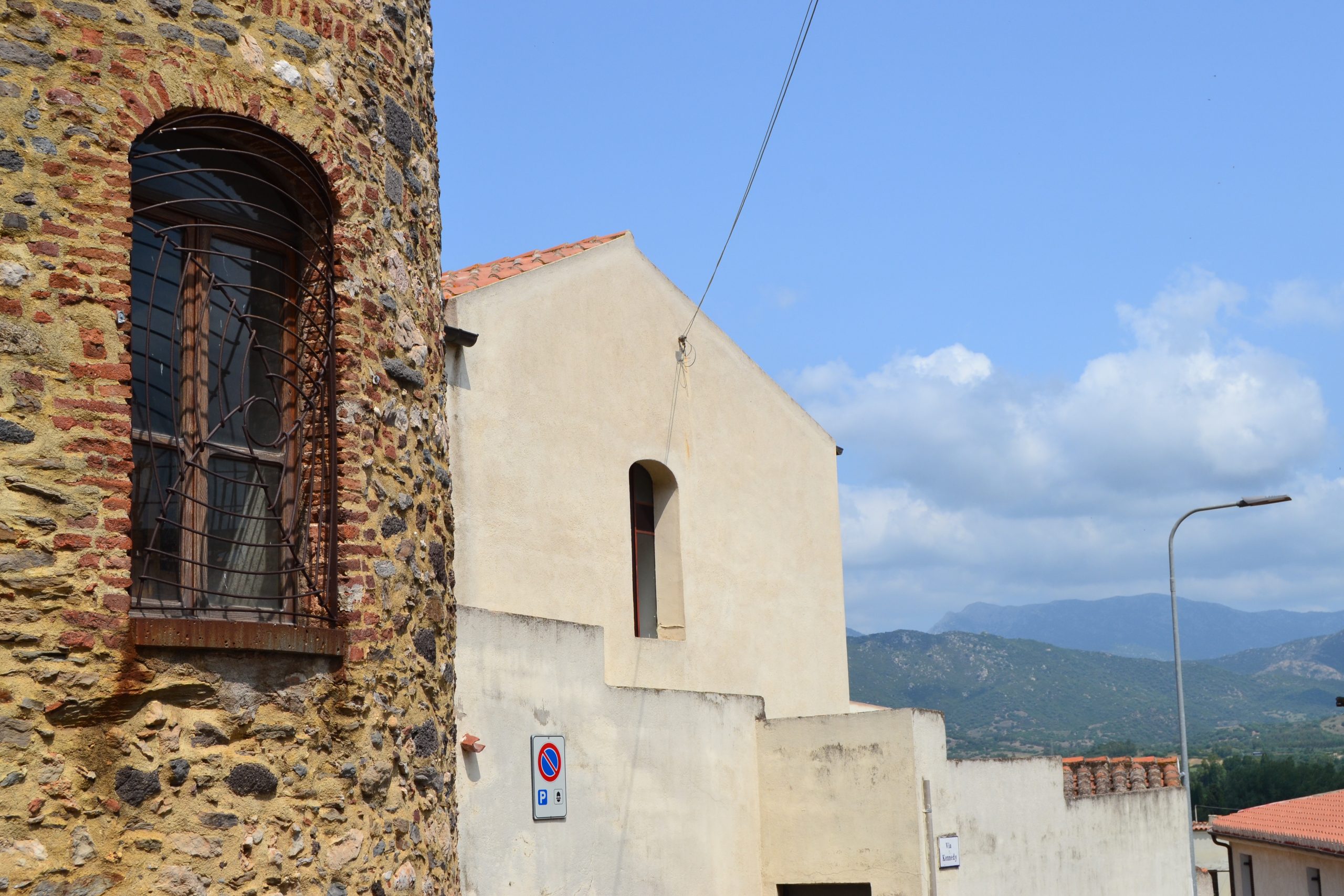“Efix walks, small and dark amidst so much luminous grandeur. The slanting sun makes the entire plain sparkle; every reed has a thread of silver, from every euphorbia bush rises a bird's cry; and there is the green and white cone of Mount Galte, furrowed by shadows and strips of sunlight, and at its feet the village that seems composed only of the ruins of the ancient Roman city.”
Translation of the provided text by Grazia Deledda, Canne al vento (Reeds in the Wind), ed. Ilisso, 2005, p.37
How to get there
By Bus
The ARST bus lines 529 Nuoro-Galtellì and 521 Dorgali-Siniscola make stops in Galtellì.
By Car
From Cagliari, Oristano, Sassari, and Nuoro, you can reach the Lula-Dorgali junction on the 131 D.C.N. After that, follow the signs for Provincial Road 25, towards Orosei/Galtellì. After 8 kilometers, turn right for Galtellì.
Galtellì is also accessible from State Road 129, Trasversale Sarda, which passes through Galtellì.
Galtellì is a village rich in history, art, and culture, setting for the novel “Canne al vento (Reeds in the wild)” by Nobel Prize-winning writer Grazia Deledda. A Literary Park has been established, suggesting itineraries to visit the places described in the novel, along with other attractions in the village. Among these, the Romanesque Cathedral of San Pietro, dating back to the 9th century, stands out. The village’s historical and religious heritage is evidenced by numerous churches scattered throughout the urban and rural areas.
In the center of Galtellì, various historical churches can be explored, with one of the most important being the Church of the Holy Crucifix, dating back to the 16th century. It houses a wooden statue of Christ from the 13th century, attributed with miraculous powers. Not far from this church, you can also visit the Church of Santa Croce (Holy Cross), home to one of the two confraternities* in Galtellì. To visit the churches, it is advisable to make an appointment in advance with the parish priest or a representative through the Parish website.
In the inhabited center, you can visit Sa domo ‘e Marras, an ethnographic museum set up in a historic house, and the municipal park Malicas, which houses a building from the early 20th century known as Castello Guzzetti. Just outside the village are the ruins of Castello di Pontes (Pontes’ Castle), built in 1070.
Throughout the year, religious celebrations are held, including those of Holy Week, where you can witness ritual songs and secular devotional practices coordinated by the two confraternities. From April 30 to May 3, the village celebrates the Holy Crucifix, the patron saint, with shows and religious and secular events.
On January 17, bonfires are lit in honor of Saint Anthony Abbot. The rural festivals of San Giuseppe, on the first Sunday of June, and Madonna d’Itria, on the first Sunday of September, are also notable.
In addition to these events, Galtellì offers interesting cultural appointments, and you can find the schedule on institutional and religious websites.
*Confraternities: Religious brotherhoods or societies. A confraternity is an association of individuals who come together in the name of a common interest, often rooted in religious faith but not necessarily limited to it. In Galtellì, there are two confraternities: the Confraternity of Santa Rughe, headquartered in the church of the same name (Church of Santa Croce), and the Confraternity of Sas Animas, based in the Church of the Blessed Virgin Assumption.
Historical Overview
The history of Galtellì dates back to the Neolithic era, gaining significance in the Middle Ages as a curatorial seat of the Lower Judicate of Gallura (later passed to Orosei) and the second diocese of Gallura. Details on Galtellì’s economic, demographic, and political aspects are found in Liber Fondachi and Repartimiento de Cerdeña, valuable sources for understanding the region’s history. Studies by Monsignor Ottorino Alberti and Monsignor Pietro Maria Marcello provide insights into the importance of this ancient episcopal seat, established in the early decades of the 13th century. By 1138, the diocese became a suffragan of Pisa, and after three and a half centuries, it was united with the diocese of Cagliari by Pope Alexander VI in 1495.
Under Savoyan rule, Pope Pius VI reinstated the diocese in 1779. The theory that the cathedral is San Pietro gains support, given the discovery of frescoes dating back to the 11th or 12th century. Certainly, the church is a repository of significant artistic heritage, especially furnishings comprising textiles, silverware, paintings, and sculptures. Throughout history, changes occurred in the structure of dioceses in Sardinia due to political and administrative reasons, influenced by territorial alterations, foreign dominations, and external political influences. Galtellì, in the Judicate period, was part of the Judicate of Gallura, covering the northeastern part of the island. The diocese of Galtellì was likely founded in the third decade of the 12th century, initially under the direct dependence of the Holy See, along with another diocese in the Judicate of Gallura, Civita (ancient name for the city of Olbia).
In 1138, a document by Pope Innocent II stipulated that the Gallurese dioceses would come under the administration of the archdiocese of Pisa. The diocese of Galtellì was formed by taking territories from the original diocese of Civita, including the curatoriae of Galtellì-Orosei, Barbagia di Bitti, Orfili, and Posada, constituting the territory of the so-called lower Gallura. The motivations behind choosing a diocesan seat in a center characterized by low population density remain unclear. A more in-depth analysis reveals favorable elements considered when establishing the diocesan seat. On July 21, 1779, with Pope Pius VI’s papal bull “Eam inter caeteras,” the episcopal seat was reinstated as the “Diocese of Galtellì-Nuoro,” under the archdiocese of Cagliari. Simultaneously, the bishop’s residence was moved from Galtellì to Nuoro. On January 27, 1928, the diocese changed its name to the “Diocese of Nuoro.”
Galtellì was likely a small center but strategically located, protected by Mount Tuttavista and man-made fortifications (Pontes Castle). Positioned away from the sea, a source of danger, yet not too far for trade, it held strategic significance. With the collapse of the Judicate of Gallura, it became the possession of the municipality of Pisa in 1288. Subsequently, with the start of Aragonese domination, the diocese returned under the direct dependence of the Holy See, and control was taken away from the archdiocese of Pisa. Between the 12th and 13th centuries, a matrimonial policy unfolded between Pisan and Genoese noble houses and the families of local judges, leading to the fall of the Judicate of Gallura under the Visconti dynasty. In 1326, Galtellì came under Aragonese rule until 1478. From 1459, it became a fiefdom of the Guiso family, and in 1645, King Philip IV of Spain granted them the title of Marquises of Albis. The fief remained with the Guiso family until 1808 when, due to succession issues, it was ceded to the Royal Domain. Galtellì thus became part of the state domain, later redeemed in 1838, and in 1946, with a Lieutenant Decree, it finally became an Autonomous Municipality.
Galtellì’s history was marked by significant challenges such as malaria, famines, and floods. Malaria posed a threat to the local population, leading to a high mortality rate and poor quality of life. Efforts to combat malaria included land reclamation and the use of repellents, but the scourge persisted. Over the centuries, the region experienced famines due to adverse climatic conditions, limited water resources, and agricultural practices. These famines resulted in food shortages, reduced agricultural production, and suffering. Additionally, a violent flood in 1951 and a cloudburst in 2004, causing the overflow of the Cedrino River, caused significant hardships and extensive damage to the entire town, including buildings housing historical documents. It became necessary to transfer the historical archive to a different location to prevent further deterioration due to high humidity. Document dispersals occurred when the Municipality of Galtellì was merged with Irgoli (1927-1946).
Nature
Galtellì, nestled between the Cedrino River and Mount Tuttavista, boasts a diverse array of habitats—from plains and rivers to countryside and mountains—fostering a thriving biodiversity of mammals and birds. In the plains, one can spot river species like water rails, coots, and the Sultan chicken, a species highly protected in Europe. On solid ground, partridges, hares, buzzards, and kestrels are common. As you ascend towards the mountains, the Mediterranean scrub becomes a habitat for wild birds, jays, wood pigeons, martens, foxes, hawks, and goshawks. At higher elevations, mouflons are absent due to water scarcity, but historically, eagles nested in the region. The peregrine falcon, closely associated with mountainous terrain, is also prevalent. Boars become more frequent with elevation, while the presence of rabbits, once abundant, remains uncertain today.
The limestone massif of Tuttavista, reaching 806 meters, stands as the northernmost branch of the Supramonte complex. Characterized by rugged morphology and numerous caves and karstic cavities, the massif hosts a vegetation dominated by Mediterranean scrub, including holm oak, juniper, strawberry tree, and wild olive. It is also home to endemic species such as the dwarf palm (Chamaerops humilis), Crocus minimus, Centaurea filiformis, Polygala sardoa, Campanula forythii, Euphorbia spinosa, Lactuca longidentata, and various others. Orchids are abundant, with 32 species, representing 60% of Sardinia’s total, including Orchis brancifortii, Orchis mascula ichnusae, and Orchis morisii.
The fauna is rich with wild boars, foxes, weasels, and martens. Birdwatchers can observe imperial crows, kestrels, hoopoes, partridges, and buzzards. Additionally, hobby falcons, buzzards, peregrine falcons, a southern Mediterranean variety nesting on Mount Tuttavista, jays, doves, long-eared owls, and hoopoes are present. Endemic species residing in karstic cavities include arthropods like the pseudoscorpion Microcreagris (Acanthocreagris) sardoa, insects like the carabid beetles Speomolops sardous and Sardaphaenops supramontanus, and amphibians like the cave salamander (Speleomantes supramontis).
Art and Craftsmanship
Silverware
In Sardinia, diverse regional influences, including Genoese, Roman, Neapolitan, and Sicilian craftsmanship, have contributed to the island’s artistic heritage alongside Iberian traditions. The presence of silver in Sardinia dates back to ancient times, as evidenced by archaeological finds in Iglesias and Sulcis. Notably, Galtellì’s processional cross showcases local originality and interpretation rooted in precise models, affirming the island’s rich tradition of goldsmithing and silversmithing. The silver and bronze chalice from Galtellì is intricately adorned with Renaissance floral patterns executed in relief and chasing. In contrast, the pyx features a simple and linear structure, softly molded in rounded forms, reflecting the elegance and classical sobriety of the 16th century. Another chalice, possibly crafted by a different artist, is simpler in both decoration and structure, sharing some elements with the previous one. The standout piece among Galtellì’s furnishings is a gold chalice from 1617, showcasing virtuosity in elegant refinement linked to the Renaissance and foreshadowing Baroque art.
Textiles
Galtellì’s textile works, numbering 15 in total, include seven planets, two of which are embroidered; two tunics; a chasuble; a tabernacle cover; a chalice veil; a frontal; a faldstool; and an embroidered banner. Despite the need to adhere to the rules of the Holy See, sacred vestments were not immune to contemporary trends. Embroidery played a significant role in textile history, with ecclesiastical embroideries serving as poignant evidence of the richness and diligence with which they were executed.
Wooden Sculptures
Specialized historiography has focused on wooden sculpture within Sardinia’s artistic production. The fundamental distinction between sculptures in marble, stone, or wood lies in their destination and purpose. Stones and marbles were used for sculptures in architecture, as external or internal decorative elements or within burial complexes. Woods, however, were employed for the execution, decoration, and representation of sacred images, intended for temporary display—easy to handle and transport. In Galtellì, the prevalence of these statues, predominantly sacred, is perhaps indicative of the people’s profound religiosity. The surviving works, mostly sacred and rare, originate from churches like SS. Crocifisso, San Pietro, S. Francesco, S. Giovanni, and S. Caterina, and the oratory of S. Croce, comprising 47 elements of diverse iconography. The analysis of these works is challenging due to severe damage, with the most representative being the wooden Crucifix group flanked by the Madonna and St. John the Evangelist.
Where to eat and where to Stay
Galtellì is a community that boasts a rich culinary tradition and a strong sense of hospitality. For this reason, it is easy to find high-quality restaurants and comfortable accommodation in the village. For information on where to eat and sleep in Galtellì, you can check the official website of the municipality or get in touch with the local Pro Loco (tourist information center).


